What makes Fiat the big draw
 First published by Campaign, November 1988
First published by Campaign, November 1988With the death of Sergio Marchionne, can Fiat-Chrysler’s new CEO, Jeep chief Mike Manley, continue the car giant’s renaissance?
One thing is clear: with plain old Fiat, at least, history and the brand’s visual associations have always meant a lot. Fiat brought Britain the ‘Handbuilt by Robots’ ad campaign in 1979; in 1988, it used a massive Science Museum exhibition to show how it had pioneered motoring art in pre- and post-war Italy…
First published by Campaign, November 1988
They say that, in 1934, when Marcello Dudovich published a poster comparing the new Balilla car with female elegance, the Vatican was outraged. Noticing that Dudovich had arranged for the hem of a pair of knickers to be visible through his striding woman’s blue dress, Osservatore Romano – the Popes own newspaper – denounced the ad.
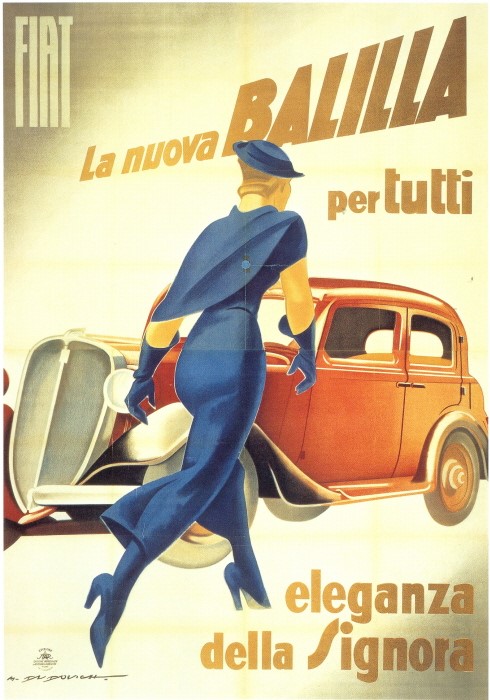
The Balilla (1934) by Marcello Dudovich: ‘the most famous bottom in Italian advertising history’
Fiat, however, paid no attention; and now the most famous bottom in Italian advertising history is, along with many other transcendent pieces of Fiat graphic design, on display at the Science Museum along with 90 years of the firm’s vehicles. Fiat: An Italian Industrial Revolution is the largest exhibition ever mounted by a single firm in UK. The cars and the scale models are wonderful, but the advertising alone is worth a visit. Like Fiat and the Balilla lady’s gait, the images are purposeful, determined. Like her posterior, many are also superbly outrageous.
They are outrageous not just because of the brazen decadence and sensuality of Dudovich’s women, but because quite a few of the posters date from the years of Mussolini’s rule, 1922-1943. Yet despite their fascist associations, they are so good! To look, for instance, at the massively architectural Fiat 154 drawn in 1929 by Plinio Codognato, director for the house magazine Fiat Rivista, is to feel at once enthralled by its grandeur, yet guilty that such delight can be prompted by an aesthetic with strong overtones of il Duce.
Based in Turin, epicentre of socialist factory occupations after the First World War, Fiat had no time for the use of photography in the era of Benito. Instead of deploying the realism of the camera, the humorous and subversive sides to Futurism and Surrealism, or the design-almostfor-its-own-sake approaches that Olivetti applied in the 1960s, Fiat used well-known Italian artists to paint its cars as respectable – for then – metaphors for power, speed, women, and empires both Roman and fascist in inspiration.
In the world of art the Futurists, of course, had long been fascinated with the explosive sound and motion of the car – symbol of an industrialising, modern Italy whose arrival was, in the opinion of Marinetti and his co-conspirators, long overdue. It was therefore no surprise that Fiat, which began the century with a luxury-car export marketing offensive based on excellence in motor racing, should move into mass production at its Lingotto plant (1922) with foot-on-the-pedal posters, chiefly displayed at new and internationally popular motor shows.
Nor was the female form a novelty: the Surrealists had loved to deploy the nude as a thought-provoking symbol of ambiguity. But for Fiat things were different. With Codognato the motifs revolve around not just momentum, but the conquest of a Caesar, or the charms of a pretty young boy decked out in a black-shirt. Likewise, with Dudovich the women are all dressed, dressed well and tightly, too. Here the women suggest not so much mystery as the pleasures of the flesh. They hold above their heads, in firm and muscular style, a giant tin of Fiat Superoil, or a barely-miniaturised Fiat 519.
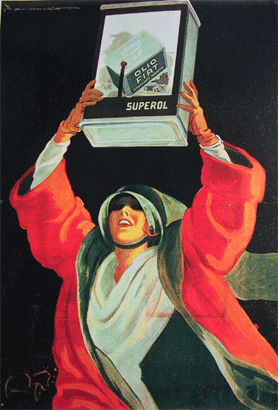
Dudovich’s ‘Olio Fiat Superoil’ (1925): less about foot-on-the-pedal acceleration than about the pleasures of the flesh
Mario Sironi, third in a Fiat poster design triumvirate (with Codognato and Dudovich), sums up the evolution of Italian advertising graphics in the inter-war period. Once a Futurist, full of abstract and challenging compositions, he spent the 1930s painting dark brown, militaristic trucks and centurions pounding their way through African mountains, or cars set against the Italian flag, or the she-wolf mother of RomuIus and Remus, founders of Rome.
Sironi’s sad, bold, broad-brush statements were not at all like the refined colours and curves of Marcello Nizzoli, the Italian poster’s answer to France’s Cassandre. Yet though Nizzoli was a master and earned the patronage of both Campari and Olivetti, Sironi’s more totalitarian work still has an undeniable force to it.
After the Liberation, Fiat’s artists, dominated by a sunnily democratic Sironi, a post-surrealist Giorgio de Chirico and a famous Pietro Annigoni, confined themselves in the main to works on canvas. For more directly commercial publicity, Fiat turned away from illustrated posters to photographic ones. Naturally, the post-war Americanisation of Italian advertising rid Fiat’s campaigns of old, ‘reactionary’ graphic devices; but the company’s visual output was, on the whole, the poorer for it.
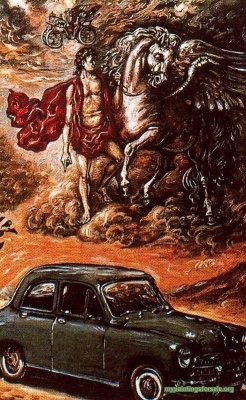
Fiat 400 (1949), by Giorgio de Chirico. He left his surrealism behind for the 50th anniversary of Fiat’s birth
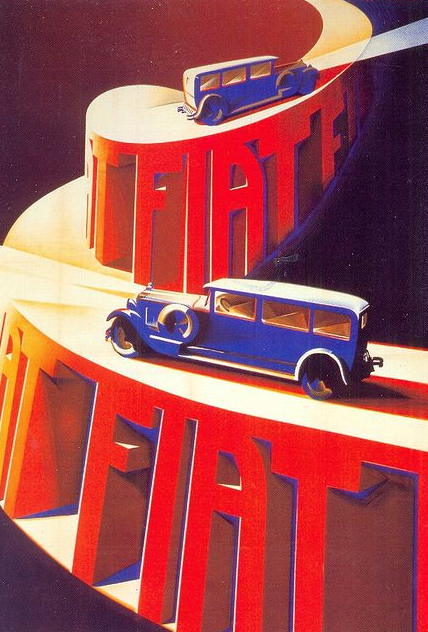
Giuseppe Riccobaldi del Bava, Fiat 520 on the ramp at Lingotto, 1928
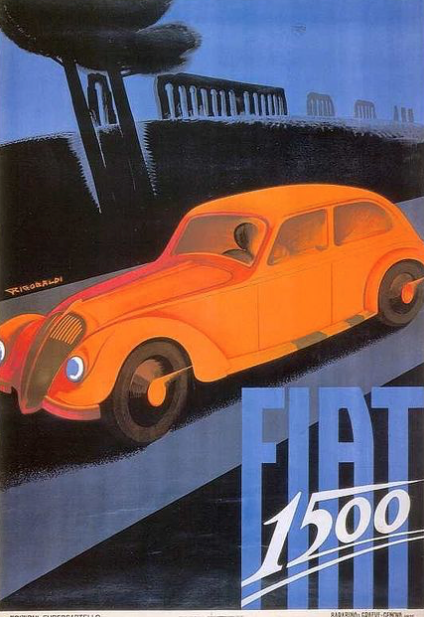
Riccobaldi, Fiat 1500A, circa 1935
The question now facing Giuliano Lonardi, Fiat’s head of corporate image, is whether the photographic techniques that have ruled automotive ads for the past 40 years will be striking enough really to help keep Fiat in its place as European Ieader in cars. As overcapacity looms for every producer, and VW’s Golf mounts stiff resistance to Fiat’s Tipo in reliability-conscious Nordic markets, it may be time for Turin to make one of its cautious design innovations.
Lonardi, whose idea the Science Museum exhibition is, pleads for a new Edward Hopper to capture motorists’ imagination with the help of Fiat advertising: ‘I have a dream’, he enthuses, pointing to the relative cheapness of ilIustration, and its ability to convey messages more subtly than a snapshot ever can.
He may be right. But we can be sure that there can, will and should be no return to the posters of yesteryear. They are paradoxes that are hard to plain, and that is why they command our attention today.
The illustration at the top of this article is of the Fiat 508C with Italian flag (1937), by Mario Sironi. He specialised in images of imperial glory
"betray their immigrant heritage?"
This is flat-out white supremacist ancestry analytics. Values aren't genetically encoded by background & progressive poison like this is indistinguishable from far-right bigotry. @theipaper should be ashamed for giving this venal racism credit.
@jameswoudhuysen #Phrenology was reborn, with the dawn of #IdentityPolitics, and this #Stanford study is #pseudoscience in its purest form.
Articles grouped by Tag
Bookmarks
Innovators I like

Robert Furchgott – discovered that nitric oxide transmits signals within the human body

Barry Marshall – showed that the bacterium Helicobacter pylori is the cause of most peptic ulcers, reversing decades of medical doctrine holding that ulcers were caused by stress, spicy foods, and too much acid

N Joseph Woodland – co-inventor of the barcode

Jocelyn Bell Burnell – she discovered the first radio pulsars

John Tyndall – the man who worked out why the sky was blue

Rosalind Franklin co-discovered the structure of DNA, with Crick and Watson

Rosalyn Sussman Yallow – development of radioimmunoassay (RIA), a method of quantifying minute amounts of biological substances in the body

Jonas Salk – discovery and development of the first successful polio vaccine

John Waterlow – discovered that lack of body potassium causes altitude sickness. First experiment: on himself

Werner Forssmann – the first man to insert a catheter into a human heart: his own

Bruce Bayer – scientist with Kodak whose invention of a colour filter array enabled digital imaging sensors to capture colour

Yuri Gagarin – first man in space. My piece of fandom: http://www.spiked-online.com/newsite/article/10421

Sir Godfrey Hounsfield – inventor, with Robert Ledley, of the CAT scanner

Martin Cooper – inventor of the mobile phone

George Devol – 'father of robotics’ who helped to revolutionise carmaking

Thomas Tuohy – Windscale manager who doused the flames of the 1957 fire

Eugene Polley – TV remote controls



0 comments